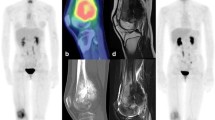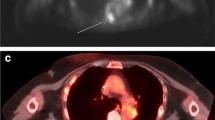Abstract
18F-fluorodeoxyglucose positron emission tomography/computed tomography (FDG PET/CT) is a widely used imaging modality in cancer patients. However, there are many potential non-neoplastic causes of FDG uptake. We report a case of FDG uptake between the spinous processes, secondary to Baastrup’s disease. Knowledge of this pattern of uptake is helpful in diagnosing Baastrup’s disease and avoiding false-positive diagnoses.
Similar content being viewed by others
Explore related subjects
Discover the latest articles, news and stories from top researchers in related subjects.Avoid common mistakes on your manuscript.
Introduction
Baastrup’s disease is characterized by the close approximation and contact of adjacent spinous processes (kissing spine). We report a case of uptake in the interspinous bursa secondary to Baastrup’s disease identified on a 18F-fluorodeoxyglucose positron emission tomography/computed tomography (FDG PET/CT) exam.
Case report
A 56-year-old man with lung cancer underwent a FDG PET/CT exam. Axial PET/CT images demonstrated FDG uptake that appeared to lie in a lumbar spinous process (Fig. 1). The patient had point tenderness at this level. CT images (5-mm contiguous sections) demonstrated a characteristic appearance of the spinous process consistent with Baastrup’s disease (Fig. 2). Sagittal PET/CT images (Fig. 3) demonstrated that the uptake was between two spinous processes. The patient’s point tenderness was relieved after local anesthetic injection.
Sagittal PET/CT scan demonstrates that the uptake is not in a spinous process, but between two spinous processes (arrow). A lesser degree of uptake is also noted between the spinous processes one level higher (arrowhead). The spinous processes are closely apposed and on axial images it is difficult to distinguish uptake between the spinous processes from uptake in the spinous process itself, even with PET/CT. However, this distinction can easily be made with sagittal images
Discussion
18F-fluorodeoxyglucose positron emission tomography/computed tomography is now widely used in cancer patients for primary diagnosis, staging, restaging, and therapy follow-up. PET is particularly helpful in the diagnosis of lytic bone metastases [1]. The spine is a common site of skeletal metastases. As fluorodeoxyglucose is a nonspecific tracer with uptake in a wide range of inflammatory and infectious processes, there are many potential false-positive findings on PET/CT exams [2]. However, PET has fewer false-positive results in the spine than bone scans with 99mTc-diphosphonate [3]. The addition of a fused CT in PET/CT exams increases the specificity further [4], as uptake in degenerative changes can be identified on the CT portion of the exam. While uptake in degenerative spinal disease is less common on PET than on a bone scan, in one study incidental findings on PET related to degenerative spinal disease were seen in 22% of patients [5]. This uptake was most common in the lumbosacral spine and could be recognized on CT. However, there is substantial variability between the degree of FDG uptake in the spine and the severity of CT findings, suggesting that the degree of FDG uptake is related to the severity of active inflammation in areas of degenerative disease [5]. FDG uptake in the spine has been described related to the facet joints and disc spaces [5]. To the author’s knowledge, FDG uptake between the spinous processes has not previously been described.
Baastrup’s disease is characterized by the close approximation and contact of adjacent spinous processes (kissing spine) [6–11]. An adventitious bursa is present in the interspinous space related to a repeated shearing movement between adjacent spinous processes [7]. The FDG uptake in this case is in the region of this bursa. The apposing surfaces of the spinous processes demonstrate enlargement, flattening and sclerosis as seen in Fig. 2. Baastrup’s disease presents clinically as localized lumbar tenderness and pain on spine extension, which is relieved by flexion. It can be treated by local anesthetic injection or excision of the spinous processes involved [7]. While this patient was symptomatic, we have noted patients with mild degrees of FDG uptake between the spinous processes who were asymptomatic. This is not surprising, as FDG uptake can be seen in mild subclinical infection or inflammation [12]. The diagnosis of Baastrup’s disease has been previously reported on bone single photon emission computed tomography (SPECT) [13], but not FDG PET. Knowledge of the appearance of the Baastrup’s disease on FDG PET/CT is important to avoid confusion with a spinous process lesion. Baastrup’s disease can mimic a spinous process lesion on axial PET/CT images; correlation with sagittal images is necessary to make the correct diagnosis. As spinous process metastases are rare, sagittal images should be carefully reviewed when apparent spinous process uptake is noted on axial images. In addition, identifying FDG uptake between the spinous processes on a PET/CT exam in a symptomatic patient identifies a treatable etiology of back pain. While we have not observed FDG uptake in the spinous process itself related to Baastrup’s disease, this would not be unexpected given that osseus FDG uptake is often seen in inflammatory disorders [5] and spinous process uptake of 99mTc-diphosphonate has been previously noted on bone SPECT [13]. In these cases the presence of associated FDG uptake in the interspinous bursa and the characteristic radiographic appearance of the spinous process could aid in differentiating this uptake from metastatic disease.
References
Nakamoto Y, Cohade C, Tatsumi M et al. CT appearance of bone metastases detected with FDG PET as part of the same PET/CT examination. Radiology 2005; 237(2): 627–634.
Gorospe L, Raman S, Echeveste J et al. Whole-body PET/CT: spectrum of physiological variants, artifacts and interpretative pitfalls in cancer patients. Nucl Med Commun 2005; 26(8): 671–687.
Bohdiewicz PG, Wong CY, Kondas D, Gaskill M, Dworkin HJ. High predictive value of F-18 FDG PET patterns of the spine for metastases or benign lesions with good agreement between readers. Clin Nucl Med 2003; 28: 966–970.
Metser U, Lerman H, Blank A et al. Malignant involvement of the spine: assessment by 18F-FDG PET/CT. J Nucl Med 2004; 45: 279–284.
Rosen RS, Fayad L, Wahl RL. Increased 18F-FDG uptake in degenerative disease of the spine: characterization with 18F-FDG PET/CT. J Nucl Med 2006; 47(8): 1274–1280.
Resnick D. Degenerative diseases of the vertebral column. Radiology 1985; 156: 3–14.
Bywaters EG, Evans S. The lumbar interspinous bursae and Baastrup’s syndrome: an autopsy study. Rheumatol Int 1982; 2: 87–96.
Beks JW. Kissing spines: fact or fancy? Acta Neurochir (Wien) 1989; 100: 134–135.
Brailsford JF. Deformities of the lumbo-sacral regions of the spine. Br J Surg 1929; 16: 562–627.
Hazlett J. Kissing spines. J Bone Joint Surg 1964; 46A: 1368–1369.
Chen CK, Yeh L, Resnick D et al. Intraspinal posterior epidural cysts associated with Baastrup’s disease: report of 10 patients. AJR Am J Roentgenol 2004; 182: 191–194.
Zhuang H, Alavi A. F-18 fluorodeoxyglucose positron emission tomographic imaging in the detection and monitoring of infection and inflammation. Semin Nucl Med 2002; 32: 47–59.
Hamlin LM, Delaplain CB. Bone SPECT in Baastrup’s disease. Clin Nucl Med 1994; 19: 640–641.
Author information
Authors and Affiliations
Corresponding author
Rights and permissions
About this article
Cite this article
Lin, E. Baastrup’s disease (kissing spine) demonstrated by FDG PET/CT. Skeletal Radiol 37, 173–175 (2008). https://doi.org/10.1007/s00256-007-0379-2
Received:
Revised:
Accepted:
Published:
Issue Date:
DOI: https://doi.org/10.1007/s00256-007-0379-2







